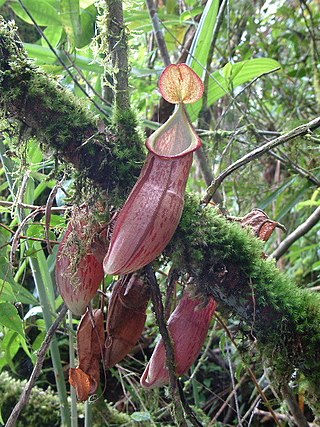Nepenthes gymnamphora
Species of pitcher plant from Indonesia From Wikipedia, the free encyclopedia
Nepenthes gymnamphora /nɪˈpɛnθiːz dʒɪmˈnæmfɔːrə/ is a tropical pitcher plant native to the Indonesian islands of Java and Sumatra. It has a wide altitudinal range of 600–2,800 metres (2,000–9,200 ft) above sea level.[3] There is much debate surrounding the taxonomic status of this species and the taxa N. pectinata and N. xiphioides.[4]
| Nepenthes gymnamphora | |
|---|---|
 | |
| Intermediate pitchers of N. gymnamphora from Sumatra | |
| Scientific classification | |
| Kingdom: | Plantae |
| Clade: | Tracheophytes |
| Clade: | Angiosperms |
| Clade: | Eudicots |
| Order: | Caryophyllales |
| Family: | Nepenthaceae |
| Genus: | Nepenthes |
| Species: | N. gymnamphora |
| Binomial name | |
| Nepenthes gymnamphora | |
| Synonyms | |
| |
The specific epithet gymnamphora is derived from the Greek words gymnos (naked) and amphoreus (pitcher).[4]
Taxonomy
Summarize
Perspective

The N. gymnamphora group of related taxa has been variously interpreted as comprising a single extremely variable species (N. gymnamphora);[4][5][6] two distinct species, one from Java (N. gymnamphora) and one from Sumatra (N. pectinata);[7][8] or two species, one with a wide distribution covering Java and Sumatra (N. gymnamphora) and one with a very restricted range in Sumatra (N. xiphioides).[9] An additional fourth undescribed taxon, known from Mount Sorik Merapi in Sumatra, may also fall within N. gymnamphora.[4]
Nepenthes pectinata
Nepenthes pectinata[a] was described by B. H. Danser in his seminal 1928 monograph "The Nepenthaceae of the Netherlands Indies".[10] Danser's description of N. pectinata was based on material that included upper pitchers of N. singalana.[4] This was first noted in 1994 by Jan Schlauer and Joachim Nerz, who provided a lectotype for N. pectinata: Bünnemeijer 700, a specimen collected on Mount Talakmau.[8][11]
Danser mentioned another specimen in his monograph that he identified as the natural hybrid N. pectinata × N. singalana,[10] but which actually represented a pure N. singalana.[4][8]
Nepenthes pectinata has a separate conservation status of Least Concern on the IUCN Red List.[12]
Nepenthes xiphioides
Nepenthes xiphioides[b] was described by Bruce Salmon and Ricky Maulder in a 1995 issue of the Carnivorous Plant Newsletter.[9] The authors treated N. pectinata as conspecific with N. gymnamphora, and distinguished N. xiphioides from the latter based on a number of characters shown in the table below.
| Morphological character | N. gymnamphora | N. xiphioides |
|---|---|---|
| Longitudinal leaf veins | 3-6 running in outer 2/3- 4/5 of blade | 2-3 running in outer 1/2 of blade |
| Leaf margins | covered with short dense hair | glabrous |
| Rosette leaf tendril | about as long as the pitcher | 2-3 times as long as the leaf |
| Rosette pitchers | 8–12 centimetres (3–5 in) tall, 3–4 centimetres (1–2 in) broad | 4–5.5 centimetres (1.6–2.2 in) tall, 1.5–2 centimetres (0.6–0.8 in) broad |
| Aerial pitchers | present | absent |
| Peristome teeth | 3-6 times as long as broad | 6-8 times as long as broad |
| Inflorescence | mostly 2 flowered, upper most ones 1 flowered; rarely most or all of them 1 flowered | 1 flowered but bearing some 2 flowered pedicels in lower 1/3 |
| Staminal column | hairy at base or over whole length | glabrous |
Infraspecific taxa
- Nepenthes gymnamphora var. haematamphora Miq. (1851)
- Nepenthes gymnamphora var. pectinata (Danser) Hort.Westphal (1999) in sched.
Natural hybrids
- N. bongso × N. gymnamphora[4]
- N. gymnamphora × N. mikei[9] [=N. × pangulubauensis]
- N. gymnamphora × N. ovata[9]
- N. gymnamphora × N. reinwardtiana[4]
- ? N. gymnamphora × N. rhombicaulis[5]
- N. gymnamphora × N. singalana[4]
- N. gymnamphora × N. spathulata[4]
- N. gymnamphora × N. spectabilis[4]
- N. gymnamphora × N. talangensis[4]
- ? N. gymnamphora × N. spectabilis
Notes
- a.^ Nepenthes pectinata is pronounced /nɪˈpɛnθiːz ˌpɛktɪˈnɑːtə/. The specific epithet is derived from the Latin word pectinata, meaning "comb-shaped".
- b.^ Nepenthes xiphioides is pronounced /nɪˈpɛnθiːz zɪfiːˈɔɪdiːz/. The specific epithet is derived from the Neo-Latin word xiphius (sword) and the Latin ending -oides (resembling), and refers to the long, thin teeth lining the inner margin of the peristome of this species.[9]
References
Further reading
External links
Wikiwand - on
Seamless Wikipedia browsing. On steroids.


